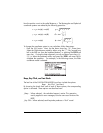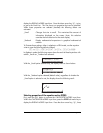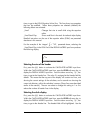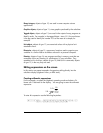
Page 2-1
Chapter 2
Introducing the calculator
In this chapter we present a number of basic operations of the calculator
including the use of the Equation Writer and the manipulation of data objects in
the calculator. Study the examples in this chapter to get a good grasp of the
capabilities of the calculator for future applications.
Calculator objects
Any number, expression, character, variable, etc., that can be created and
manipulated in the calculator is referred to as an object. Some of the most
useful type of objects are listed below.
Real. These object represents a number, positive or negative, with 12 significant
digits and an exponent ranging from -499 to +499. example of reals are: 1.,
-5., 56.41564 1.5E45, -555.74E-95
When entering a real number, you can use the V key to enter the exponent
and the \ key to change the sign of the exponent or mantissa.
Note that real must be entered with a decimal point, even if the number does
not have a fractional part. Otherwise the number is taken as an integer
number, which is a different calculator objects. Reals behave as you would
expect a number to when used in a mathematical operation.
Integers. These objects represent integer numbers (numbers without fractional
part) and do not have limits (except the memory of the calculator). Example of
integers are: 1, 564654112, -413165467354646765465487. Note how
these numbers do not have a decimal point.
Due to their storage format, integer numbers are always maintain full precision
in their calculation. For example, an operation such as 30/14, with integer
numbers, will return 15/7 and not 2.142…. To force a real (or floating-point)
result, use function NUM ‚ï.
Integers are used frequently in CAS-based functions as they are designed to
keep full precision in their operation.
If the approximate mode (APPROX) is selected in the CAS (see Appendix C),
integers will be automatically converted to reals. If you are not planning to use


















